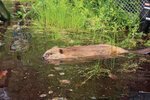

Native to Clark County, beavers can become nuisances to residents and damage properties. Before looking to remove beavers, the Washington Department of Fish and Wildlife (WDFW) urges residents to consider co-existing with the industrious creatures because of their beneficial impact on the ecosystem.
Amaia Smith, WDFW assistant regional habitat program manager, said residents often become concerned when they discover a beaver on their property. The rodents have a bad reputation for causing property damage by gnawing trees and creating unwanted ponds. Few people know the ecological benefits of having beavers and the tools available to make coexisting possible, Smith said.
“Landowners often have preconceived notions that beavers will cause major flooding, destroy landscapes or, in agricultural settings, damage infrastructure. However, these concerns are not always well-founded, and beavers may be able to coexist with humans without intervention,” according to Washington State University’s “American Beaver and Freshwater Climate Resiliency in Washington,” published in 2023. “At other times, these concerns are valid, and intervention is needed.”
Hard-working beavers were once hunted to near extinction because their pelts were considered valuable, Smith said. Protective laws regulating the trapping, relocation and hunting of beavers have helped protect their population.
“They’re native to most of North America and have a pretty widely distributed range. They are still present in where they historically were,” Smith said. “They were removed from a lot of their native range but have re-established.”
Beavers are attracted to properties with riparian — wetland adjacent — and wetland areas, where natural food sources are abundant. Land rich with aspen, one of their favorite foods, are like a buffet to beavers. They also like alder, birch, cottonwood, willow and other deciduous trees. In addition, they also eat shrubs, ferns, aquatic plants, grasses and crops like corn and beans, according to the WDFW website.
Running water, man-made or natural, also attracts beavers. Beavers living on lakes or rivers with consistent water levels will not build dams. Those living near water sources with varying levels, like tributaries, creeks and man-made culverts, will build dams, according to the WDFW website. Culverts are notorious for attracting beavers, as it resembles a dam with a hole.
“Why wouldn’t you build a dam in a culvert? Half the work is already done,” Madeline Nolan, WDFW assistant regional habitat program manager, said.
Some property owners may wish to remove beavers, rather than coexisting. Live trapping and relocation with a permit are common methods of handling bothersome beavers. The survival rate of relocated beavers is poor, however, with less than 50% surviving, according to “American Beaver and Freshwater Climate Resiliency in Washington.”
Lethal methods are another option when other efforts to dissuade beavers fail.
Though beavers can be relocated, more of the industrious creatures will likely return.
“You can trap and kill the beavers on your property, but it’s not going to stop more beavers from coming in because you have a good habitat,” Nolan said.
However, WDFW encourages property owners to coexist with beavers. Several tools are available to mitigate beaver-related property damage.
Beaver gnawing can cause significant tree damage as they forage for food or building materials. WDFW suggests loosely wrapping trunks with galvanized wire fencing, hardware cloth or chicken wire to keep beavers away. A mixture of paint and sand has also proven effective at deterring beavers from chewing, according to the WDFW website.
To reduce beaver-related flood risks, dams can be notched or have a flow device installed. Both modifications allow water to pass slowly through the dam, lowering the beaver pond’s water level. Modifying a beaver dam requires a hydraulic project approval (HPA) permit, however, which can be obtained from the WDFW or HPA webpage, wdfw.wa.gov/licenses/environmental/hpa.
Culverts can be protected by placing fences, called “beaver deceivers,” or installing a flow-control device. Beaver deceivers are v-shaped, semicircular or trapezoidal fences of woven wire mesh. The fences are secured with posts and nails, and wire skirting keeps the beavers from digging underneath and accessing the culvert, according to the WDFW website.
Beaver gnawing habits and dams are beneficial to many different native species, Smith said. Their chewing controls coniferous trees, and their dams provide a valuable water resource for other wildlife and plants.
Beavers chew coniferous trees such as native firs and pine. They deliberately kill the trees to encourage the growth of preferred food plants, using the gnawed materials for nesting, according to the WDFW website. Their coniferous culling habits help increase vegetation biodiversity.
With drier and hotter summers, beaver dams can help mitigate droughts. Their dams trap water in wetland areas and next to riverbanks.
“Because they’re impounding water, they can raise the water table and promote vegetation growth,” Smith said.
Beaver dams could save Washington significant money, according to Smith and Nolan. The ponds created by dams are particularly valuable for fish. The Salmon Recovery Funding Board has invested $1.3 billion into projects across Washington, according to the State of Salmon in Watersheds 2022 report. More beavers would result in more dams, which would provide safe habitats for young fish without government funding.
“Our native salmon populations evolved with beavers,” Smith said. “If you can have a beaver do your restoration project, you can save hundreds of thousands, if not billions of dollars.”
For more information, visit wdfw.wa.gov/species-habitats/species/castor-canadensis. To report a troublesome beaver causing property damage, contact the WDFW South West regional office at 360-696-6211 or by email at TeamRidgefield@dfw.wa.gov.